【人教版】七年级下册英语: Unit 10导学案5课时
- 格式:doc
- 大小:51.50 KB
- 文档页数:17
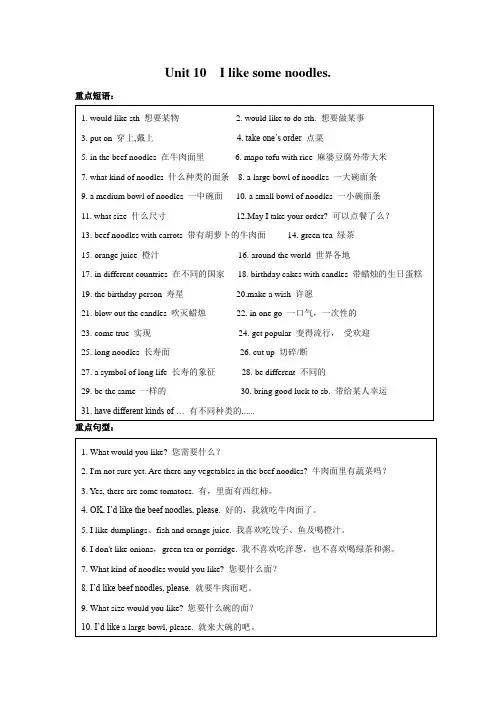
Unit 10 I like some noodles. 重点短语:重点句型:第一课时Section A (1a—2d )导学设计:1. I’d like some noodles.我想要一些面条。
【归纳】would like表示委婉地提出要求、建议或看法,与意思相同,但语气比want 委婉,多用于口语中。
would是情态动词,无人称和数的变化。
【常用的结构】would like sth.想要某物;would like to do sth. 想要做某事;would like sb. to do sth.想让某人做某事I would like some milk.我想要一些牛奶。
He would like to watch TV. 他想去看电视。
My mother would like me to go to bed early.我的妈妈想让我早点休息。
【拓展延伸】What would you like?你想要什么?Would you like sth? 你想要某物吗?Would you like to do sth?你愿意做某事吗?2. What size would you like?你想要多大号碗的?【归纳】size是名词,意为“”,既可以表示物体大小,也可以表示服装、鞋帽的尺码,大中小号分别表示为large size, medium size, small size。
what size用来提问尺寸大小,意为“多大……”。
例如:— What size shoes would you like? 你穿多大号的鞋子?— I wear size 40. 我穿40码的。
【补充】What’s the size of…? ……的尺码/大小是多少?What’s the size of the house? 这座房子有多大?3. May I take your order? 您现在可以点菜了吗?【归纳】(1) May I …?是用于的常用句型。
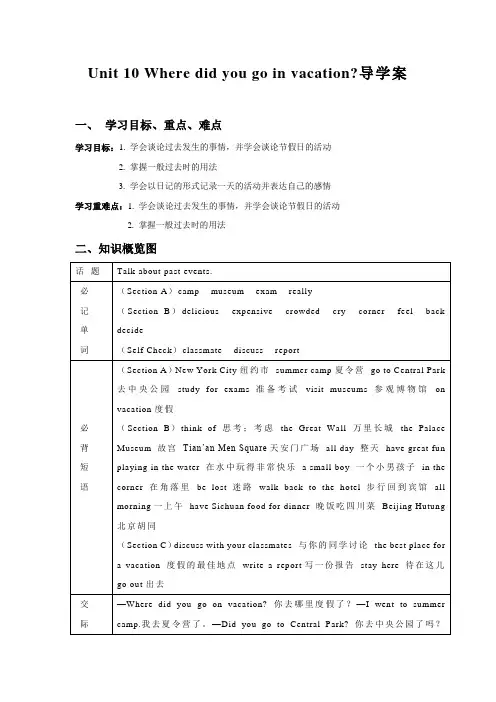
Unit 10 Where did you go in vacation?导学案一、学习目标、重点、难点学习目标:1. 学会谈论过去发生的事情,并学会谈论节假日的活动2. 掌握一般过去时的用法3. 学会以日记的形式记录一天的活动并表达自己的感情学习重难点:1. 学会谈论过去发生的事情,并学会谈论节假日的活动2. 掌握一般过去时的用法二、知识概览图三、新课导引The teacher asks the students the following questions:1. Do you like vacation? Why?2. Did you go on vacation?3. Where did you go?四、教材精华1. Where did you go on vacation?你去哪里度假了?这是一个一般过去时的特殊疑问句,其句式结构为“特殊疑问词+一般疑问句?”句中的特殊疑问词为where, did是助动词do的过去式。
On vacation为固定短语,意为“度假”,相当于on holiday.Where did he go last week? 上周他去哪里了?2. Did you / he /she/they go to Central Park?②你/他/她/他们去中央公园了吗?本句是含有实义动词的一般过去时的一般疑问句,助动词did 提前,原陈述句中的过去式改为原形,即“Did+主语+动词原形+其他?”其肯定回答为“Yes,主语+did”;否定回答为“No,主语+didn’t”.—Did she go to the beach? 她去海滩了吗?—Yes, she did./No, she didn’t. 是的,她去了。
/不,她没去。
was pretty good.相当好。
这是一个“主语+系动词+表语”句型,简称“主系表”结构。
pretty在这里为副词,意为“相当,非常”用于修饰形容词或副词。
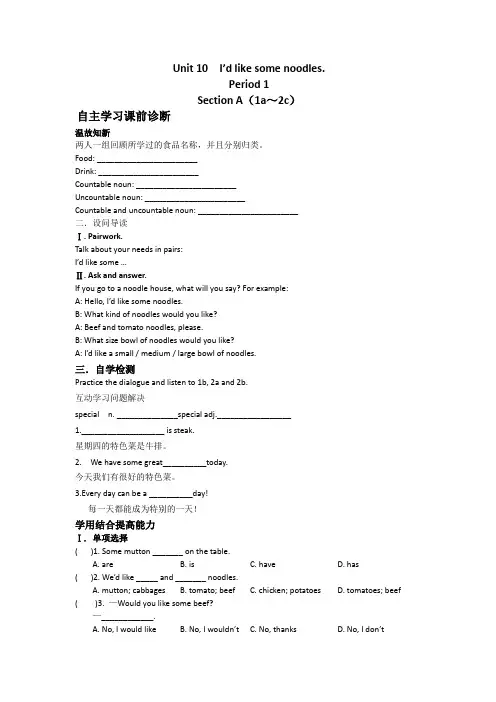
Unit 10 I’d like some noodles.Period 1Section A(1a~2c)自主学习课前诊断温故知新两人一组回顾所学过的食品名称,并且分别归类。
Food: _______________________Drink: _______________________Countable noun: _______________________Uncountable noun: _______________________Countable and uncountable noun: _______________________二.设问导读Ⅰ. Pairwork.Talk about your needs in pairs:I’d like some…Ⅱ. Ask and answer.If you go to a noodle house, what will you say? For example:A: Hello, I’d like some noodles.B: What kind of noodles would you like?A: Beef and tomato noodles, please.B: What size bowl of noodles would you like?A: I’d like a small / medium / large bowl of noodles.三.自学检测Practice the dialogue and listen to 1b, 2a and 2b.互动学习问题解决special n. ______________special adj._________________1.___________________ is steak.星期四的特色菜是牛排。
2. We have some great__________today.今天我们有很好的特色菜。
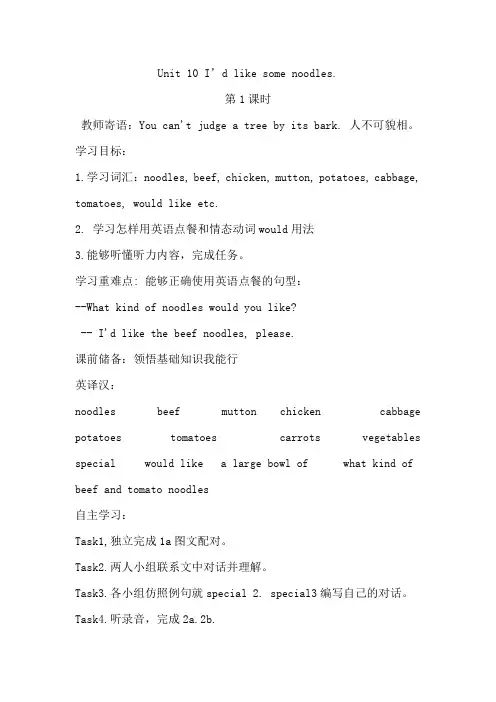
Unit 10 I’d like some noodles.第1课时教师寄语:You can't judge a tree by its bark. 人不可貌相。
学习目标:1.学习词汇:noodles, beef, chicken, mutton, potatoes, cabbage,tomatoes, would like etc.2. 学习怎样用英语点餐和情态动词would用法3.能够听懂听力内容,完成任务。
学习重难点: 能够正确使用英语点餐的句型:--What kind of noodles would you like?-- I'd like the beef noodles, please.课前储备:领悟基础知识我能行英译汉:noodles beef mutton chicken cabbage potatoes tomatoes carrots vegetables special would like a large bowl of what kind of beef and tomato noodles自主学习:Task1,独立完成1a图文配对。
Task2.两人小组联系文中对话并理解。
Task3.各小组仿照例句就special 2. special3编写自己的对话。
Task4.听录音,完成2a.2b.合作探究:1,1a中的名词中属于可数名词的是:_______________________________属于不可数名词的是_____________________________________________2,说话练习:-- What would you like? -- I'd like beef noodles,please. --What kind of noodles would you like?-- I'd like the beef noodles, please.注:1,would like的用法(1):would like 意为想要,愿意,相当于want,用于提出要求或建议;但语气比want委婉,一般有一下三种形式:①would like sth. 想要某物如:我想要些冰淇淋。
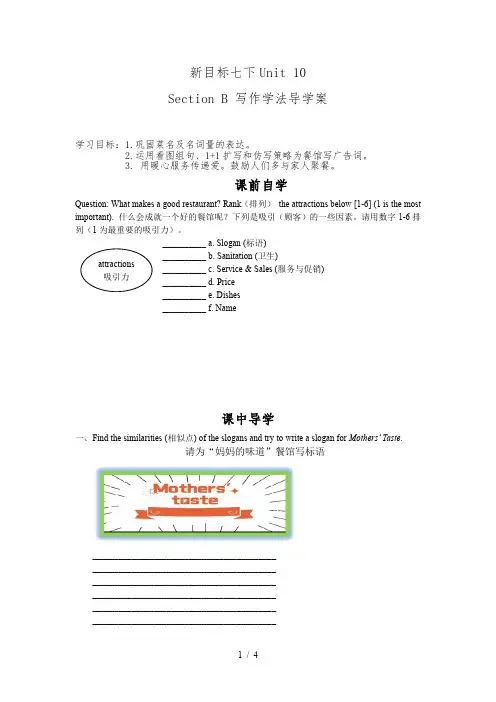
新目标七下Unit 10Section B 写作学法导学案学习目标:1.巩固菜名及名词量的表达。
2.运用看图组句、1+1扩写和仿写策略为餐馆写广告词。
3.用暖心服务传递爱。
鼓励人们多与家人聚餐。
课前自学Question:What makes a good restaurant?Rank (排列)the attractions below [1-6](1is the most important).什么会成就一个好的餐馆呢?下列是吸引(顾客)的一些因素。
请用数字1-6排列(1为最重要的吸引力)。
__________a.Slogan (标语)__________b.Sanitation (卫生)__________c.Service &Sales (服务与促销)__________d.Price__________e.Dishes__________课中导学一、Find the similarities (相似点)of the slogans and try to write a slogan for Mothers’Taste .请为“妈妈的味道”餐馆写标语____________________________________________________________________________________________________________________________________________________________________________________________________________________________________________________________attractions 吸引力二、Chose a picture that you think is the most attractive to customers,write down1-2sentences by yourself._______________________________________________________________________________ _______________________________________________________________________________ _______________________________________________________________________________三、Listen to the conversation and finish a menu.四、Introduce the specials according to the menu.1.看图组句_______________________________________________________________________________ _______________________________________________________________________________ _______________________________________________________________________________ _______________________________________________________________________________ 2.1+1写错策略练习We also have some drinks,like juice and milk.A glass of juice is20dollars._________________. The milk is only for20dollars._______________________________.After dinner,would you like some desserts?The chocolate is only for8dollars each.____________________________. Two pieces of bread are only5dollars.___________________________________.五、限时写作:15分钟写作:假如你是李华,要为新开业的“妈妈的味道”餐馆写一则英文广告,80词左右内容要求:1.简单介绍餐馆。
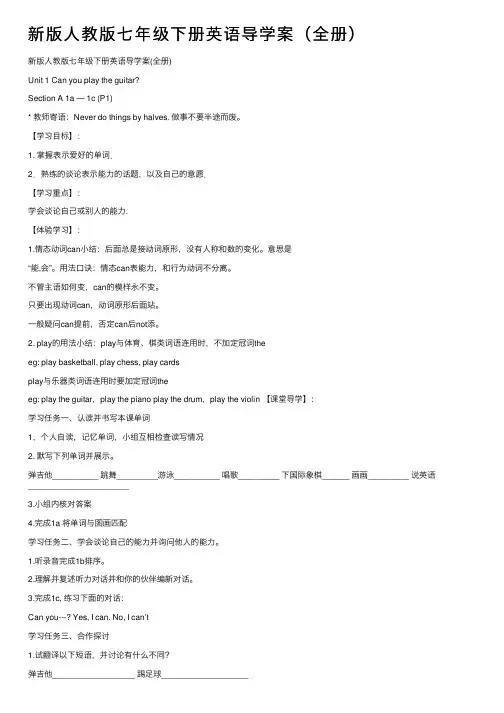
新版⼈教版七年级下册英语导学案(全册)新版⼈教版七年级下册英语导学案(全册)Unit 1 Can you play the guitar?Section A 1a — 1c (P1)* 教师寄语:Never do things by halves. 做事不要半途⽽废。
【学习⽬标】:1. 掌握表⽰爱好的单词.2.熟练的谈论表⽰能⼒的话题,以及⾃⼰的意愿.【学习重点】:学会谈论⾃⼰或别⼈的能⼒.【体验学习】:1.情态动词can⼩结:后⾯总是接动词原形,没有⼈称和数的变化。
意思是“能,会”。
⽤法⼝诀:情态can表能⼒,和⾏为动词不分离。
不管主语如何变,can的模样永不变。
只要出现动词can,动词原形后⾯站。
⼀般疑问can提前,否定can后not添。
2. play的⽤法⼩结:play与体育、棋类词语连⽤时,不加定冠词theeg: play basketball, play chess, play cardsplay与乐器类词语连⽤时要加定冠词theeg: play the guitar,play the piano play the drum,play the violin 【课堂导学】:学习任务⼀、认读并书写本课单词1,个⼈⾃读,记忆单词,⼩组互相检查读写情况2. 默写下列单词并展⽰。
弹吉他__________ 跳舞_________游泳__________ 唱歌_________ 下国际象棋______ 画画_________ 说英语______________________3.⼩组内核对答案4.完成1a 将单词与图画匹配学习任务⼆、学会谈论⾃⼰的能⼒并询问他⼈的能⼒。
1.听录⾳完成1b排序。
2.理解并复述听⼒对话并和你的伙伴编新对话。
3.完成1c, 练习下⾯的对话:Can you---? Yes, I can. No, I can’t学习任务三、合作探讨1.试翻译以下短语,并讨论有什么不同?弹吉他__________________ 踢⾜球___________________2.讨论如何询问第三⼈称能⼒的句型---Can he sing? ---Yes, he can. / No, he can't.---Can Tom speak English? ---Yes, he can. / No, he can't.【⾃主检测】:I.精挑细选1. Can you ________ English?A. speakB. talkC. say2. Can he __________ basketball?A. playB. playsC. playing3. My brother want _______ the chess club.A. joinB. to joinC. joins4. Mary can play the chess________ she can't swim.A. andB. orC. but5. His brother plays _______ piano every day.A. /B. aC. theII.翻译官说英语_____________ 弹吉他_____________ 象棋俱乐部__________ 下象棋______________ 英语俱乐部_____________ ⾳乐俱乐部__________ 美术俱乐部___________ 游泳俱乐部_____________ 参加___________ Ⅲ. 补全对话A. Can you ___________(唱歌)?B. Yes, I ________. Can you _________(游泳)?A. No, I want to join _______________(象棋俱乐部).B. I don't like ______________(象棋)A. What club do you want to __________?Unit 1 Can you play the guitar?Section A 2a— 2d (P2)* 教师寄语:Never do things by halves. 做事不要半途⽽废。
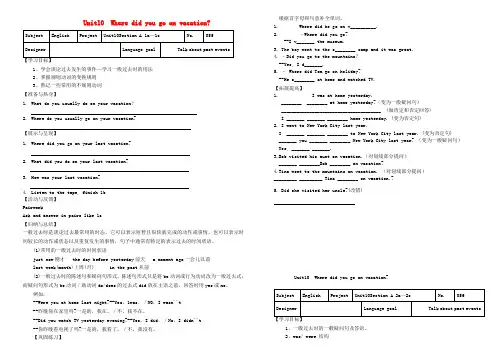
Unit10 Where did you go on vacation?【学习目标】1、学会谈论过去发生的事件—学习一般过去时的用法2、掌握规则动词的变换规则3、熟记一些常用的不规则动词【准备与热身】1.What do you usually do on your vacation?2.Where do you usually go on your vacation?【展示与呈现】1.Where did you go on your last vacation?2.What did you do on your last vacation?3.How was your last vacation?4.Listen to the tape, finish 1b【活动与反馈】PairworkAsk and answer in pairs like 1c【归纳与总结】一般过去时是谈论过去最常用的时态,它可以表示短暂且很快就完成的动作或事情,也可以表示时间较长的动作或状态以及重复发生的事情,句子中通常有特定的表示过去的时间状语。
(1)常用的一般过去时的时间状语just now刚才 the day before yesterday前天 a moment ago一会儿以前last week(month)上周(月) in the past从前(2)一般过去时的陈述句和疑问句形式。
陈述句形式只是将be动词或行为动词改为一般过去式;而疑问句形式为be动词/助动词do/does的过去式did放在主语之前,回答时用yes或no。
例如:--Were you at home last night?--Yes,1was./NO,I wasn''t--昨晚你在家里吗?一是的,我在。
/不,我不在。
--Did you watch TV yesterday evening?--Yes,I did./No,I didn''t--你昨晚看电视了吗?一是的,我看了。
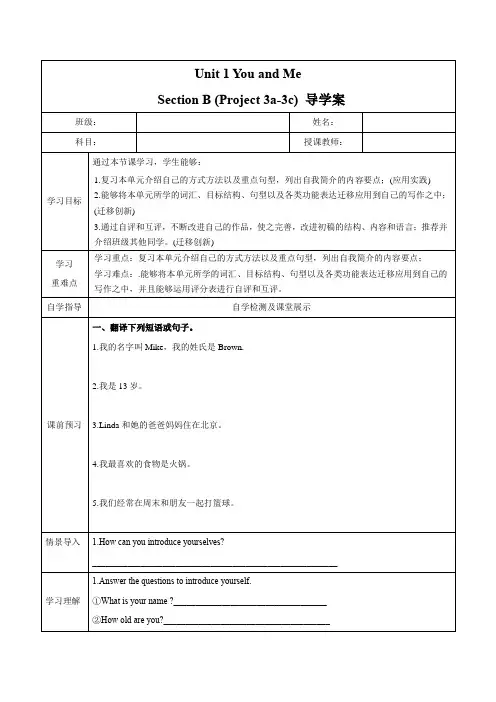
③What is your favourite sport/food?________________________④What are your hobbies?_________________________________2.What other things can you talk about yourselves?__________________________________________________3.Can you make your own personal profile?What is a personal profile?_______________________________________________________________ 4.What information can you find in Andre’s personal profile?______________________________________________________________ 5.Make an outline1.Write your own personal profiles.2.Revise your personal profile according to the assessments.name. The class will guess who he or she is.2.We have finished Unit1.Please reflect how well you have learned.3.How do we get to know each other?________________________________________________________________ 4.What do we need to know about a new friend?________________________________________________________________【参考答案】1.How can you introduce yourselves? ?1.Answer the questions to introduce yourself.2.What other things can you talk about yourselves?3.Can you make your own personal profile?What is a personal profile?4.What information can you find in Andre’s personal profile?5.Make an outline1.Take turns to pick out one classmate's profile. Introduce the person to the class, but do not say the name. The class will guess who he or she is.略2.We have finished Unit1.Please reflect how well you have learned.略3.How do we get to know each other?4.What do we need to know about a new friend?一、单项选择B AC B C二、翻译填空。
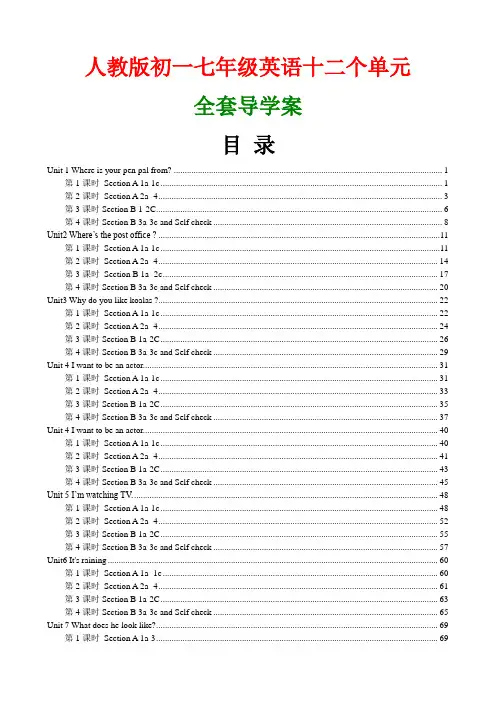
人教版初一七年级英语十二个单元全套导学案目录Unit 1 Where is your pen pal from? (1)第1课时Section A 1a-1c (1)第2课时Section A 2a -4 (3)第3课时Section B 1-2C (6)第4课时Section B 3a-3c and Self check (8)Unit2 Where’s the post office ? (11)第1课时Section A 1a-1c (11)第2课时Section A 2a -4 (14)第3课时Section B 1a -2c (17)第4课时Section B 3a-3c and Self check (20)Unit3 Why do you like koalas ? (22)第1课时Section A 1a-1c (22)第2课时Section A 2a -4 (24)第3课时Section B 1a-2C (26)第4课时Section B 3a-3c and Self check (29)Unit 4 I want to be an actor. (31)第1课时Section A 1a-1c (31)第2课时Section A 2a -4 (33)第3课时Section B 1a-2C (35)第4课时Section B 3a-3c and Self check (37)Unit 4 I want to be an actor. (40)第1课时Section A 1a-1c (40)第2课时Section A 2a -4 (41)第3课时Section B 1a-2C (43)第4课时Section B 3a-3c and Self check (45)Unit 5 I’m watching TV (48)第1课时Section A 1a-1c (48)第2课时Section A 2a -4 (52)第3课时Section B 1a-2C (55)第4课时Section B 3a-3c and Self check (57)Unit6 It's raining (60)第1课时Section A 1a -1c (60)第2课时Section A 2a -4 (61)第3课时Section B 1a-2C (63)第4课时Section B 3a-3c and Self check (65)Unit 7 What does he look like? (69)第1课时Section A 1a-3 (69)第2课时Section A 3a -4 (72)第3课时Section B 1a-2C (76)第4课时Section B 3a-3c and Self check (78)Unit 8 I’d like some noodles (83)第1课时Section A 1a-1c (83)第2课时Sectiona A 2a-4 (85)第3课时Section B 1a-2c (88)第4课时Section B 3a-4 and Self check (92)Unit9 How was your weekends? (97)第1课时Section A 1a-1c (97)第2课时Section A 2a -4 (99)第3课时Section B 1a-2C and Shelf check-3 (102)第4课时Section B 3a-3c (105)Unit 10 Where did you go on vacation? (109)第1课时Section A 1a-1c (109)第2课时Section A 3a -4 (112)第3课时Section B 1a-2C (113)第4课时Section B 3a-3c and Self check (116)Unit 11 What do you think of game shows? (119)第1课时Section A 1a-2c (119)第2课时Section A 3a -4 (123)第3课时Section B 1a-2C (125)第4课时Section B 3a-3c and Self check (128)Unit 12 Don't eat in class. (133)第1课时Section A 1a-1c (133)第2课时Section A 2a -4 (135)第3课时Section B 1a-2C (140)第4课时Section B 3a-3c and Self check (141)七年级英语下册第一单元学案Unit 1 Where is your pen pal from?第1课时Section A 1a-1c【学习目标】1. 掌握P 1 单词2.掌握句型:—Where is your pen pal from? —He is from Australia.3.掌握世界上一些国家的英文名称及地理位置。
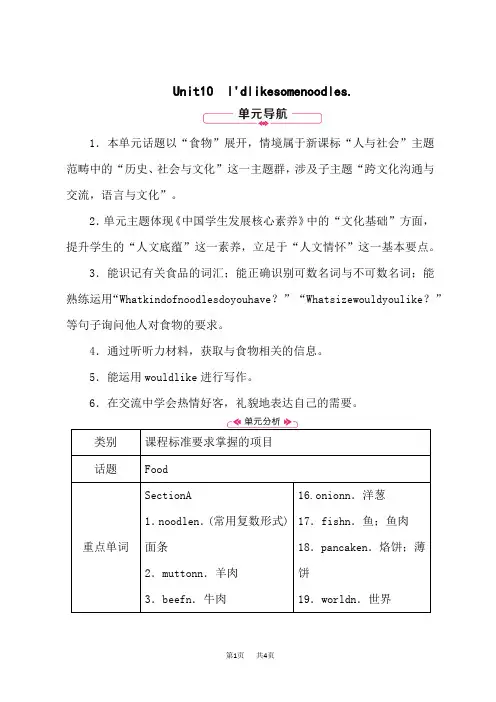
Unit10 I'dlikesomenoodles.
1.本单元话题以“食物”展开,情境属于新课标“人与社会”主题范畴中的“历史、社会与文化”这一主题群,涉及子主题“跨文化沟通与交流,语言与文化”。
2.单元主题体现《中国学生发展核心素养》中的“文化基础”方面,提升学生的“人文底蕴”这一素养,立足于“人文情怀”这一基本要点。
3.能识记有关食品的词汇;能正确识别可数名词与不可数名词;能熟练运用“Whatkindofnoodlesdoyouhave ?”“Whatsizewouldyoulike?”等句子询问他人对食物的要求。
4.通过听听力材料,获取与食物相关的信息。
5.能运用wouldlike 进行写作。
6.在交流中学会热情好客,礼貌地表达自己的需要。
续表
【课时建议】本单元建议5课时
SectionA(1a-1c)(一课时)
SectionA(2a-2d)(一课时)
SectionA(GrammarFocus-3c)(一课时)
SectionB(1a-1d)(一课时)
SectionB(2a-SelfCheck)(一课时)
词汇短语:主要采用图片及多媒体展示助记忆法。
基本句子:采用多媒体展示及交际法(利用多媒体展示两人进行交际时的情景)。
语法:学会如何点餐。
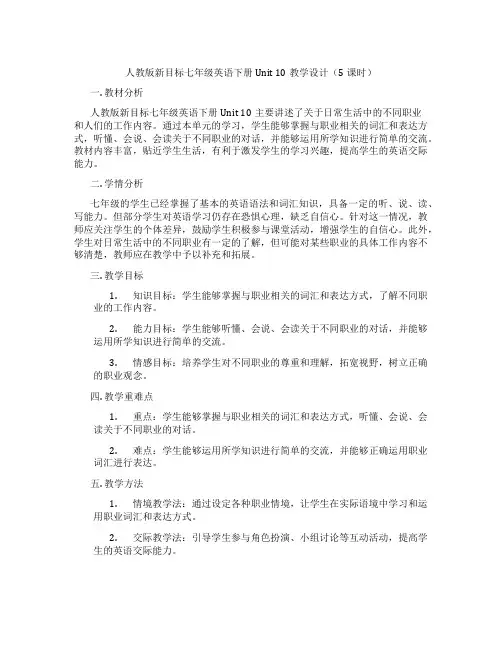
人教版新目标七年级英语下册 Unit 10教学设计(5课时)一. 教材分析人教版新目标七年级英语下册Unit 10主要讲述了关于日常生活中的不同职业和人们的工作内容。
通过本单元的学习,学生能够掌握与职业相关的词汇和表达方式,听懂、会说、会读关于不同职业的对话,并能够运用所学知识进行简单的交流。
教材内容丰富,贴近学生生活,有利于激发学生的学习兴趣,提高学生的英语交际能力。
二. 学情分析七年级的学生已经掌握了基本的英语语法和词汇知识,具备一定的听、说、读、写能力。
但部分学生对英语学习仍存在恐惧心理,缺乏自信心。
针对这一情况,教师应关注学生的个体差异,鼓励学生积极参与课堂活动,增强学生的自信心。
此外,学生对日常生活中的不同职业有一定的了解,但可能对某些职业的具体工作内容不够清楚,教师应在教学中予以补充和拓展。
三. 教学目标1.知识目标:学生能够掌握与职业相关的词汇和表达方式,了解不同职业的工作内容。
2.能力目标:学生能够听懂、会说、会读关于不同职业的对话,并能够运用所学知识进行简单的交流。
3.情感目标:培养学生对不同职业的尊重和理解,拓宽视野,树立正确的职业观念。
四. 教学重难点1.重点:学生能够掌握与职业相关的词汇和表达方式,听懂、会说、会读关于不同职业的对话。
2.难点:学生能够运用所学知识进行简单的交流,并能够正确运用职业词汇进行表达。
五. 教学方法1.情境教学法:通过设定各种职业情境,让学生在实际语境中学习和运用职业词汇和表达方式。
2.交际教学法:引导学生参与角色扮演、小组讨论等互动活动,提高学生的英语交际能力。
3.任务型教学法:布置相关职业的调查任务,让学生在完成任务的过程中,巩固和拓展所学知识。
六. 教学准备1.教学课件:制作含有不同职业图片、词汇和对话的课件,以便在课堂上进行展示和教学。
2.教学素材:准备与职业相关的图片、视频等素材,丰富教学内容,提高学生的学习兴趣。
3.调查问卷:设计一份关于学生家长职业的调查问卷,以便在课堂上进行调查和交流。
【教学目标】order food【德育目标】Unite with your classmates and be ready to help others.【重点难点】useful phrases and sentences【教学过程】二次备课预习指导:预习57、58俩页的内容,并写出下列短语:1.什么种类的面条_______________________2.牛肉面______________3.多大碗_____________________4.一大碗羊肉_________________5.西红柿鸡蛋汤________________________6.一些胡萝卜______________7.羊肉、胡萝卜面条______________________________________8.土豆沙拉____________________ 9.北街15号_________________10.12个羊肉胡萝卜饺子。
________________________________当堂训练:I. 可数名词与不可数名词专练1. How many ______________(碗) are there on the table?2. There are some __________ on the __________tree. (苹果)3. I’d like beef noodles with ____________(西红柿)I’d like beef and ___________noodles.4. Do you like ______________________(草莓)?5. Which kind of __________(水) would you like?6. In winter, I often drink ___________ soup to make me warm. (羊肉)In winter, I often drink soup with ___________ to make me warm7. She always eats ______________(冰激凌) after dinner.8. Would you like _________ _____________? (一份冰激凌)9. When the ______________ (鸡)grow up, they can make hamburgers with_______________(鸡肉)II. 完成下列句子1.西红柿鸡蛋汤里有肉吗?____ there ______ meat in the _________and _________ __________?No, _______________________ / No,____________________人教版新目标七年级英语下册Unit 10 导学案课题:Unit 10 B1 课型:New 课时数:2课时班级: 姓名:【教学目标】food tradition【德育目标】Unite with your classmates and be ready to help others.【重点难点】useful phrases and sentences【教学过程】二次备课预习指导:I. 预习并翻译下列短语和句子1.世界各地的生日食品____________________________________________2.人们吃插着蜡烛的生日蛋糕______________________________________3.蜡烛的数量_________________________________4.许个愿望并吹灭蜡烛______________________________________________5.愿望便会成真____________________________________6.在生日蛋糕里放一块糖_________________________________________7.吃到糖的那个孩子就是幸运星。
注意就餐礼仪以及东西方文化的不同。
1.学会一些食物名词。
,学习与区分可数名词与不可数名词。
,句型:注意就餐礼仪以及东西方文化的不同。
1.学会一些食物名词。
2. d likeTom likes dumplings ,fish and onions. He doesn't like meat ,pancakes or green tea.___________ _______________________________________________________________________________________________________________________________________________________________________________________________________________________________________活动二1、听1c的录音,用正确的内容填好1c中的表格。
2、听录音第二遍,核对答案。
3、听录音第三遍,模仿读音,然后填写空格A: Hello, House of dumplings! B: Hello. I want to order some _______, please.A: Sure. B: I’d like _____, _____and _____, please.A: Uh-huh. B: And sixteen ___________.A: What _____ of dumplings ______ you _______?B: Mutton and carrot dumplings, please.A: OK. _________ else? B: Oh, yes. I’d like some _________.A: OK. Then what kind of soup would you like? B: Tomato soup.A: OK. Would you like any _________?B: One large ________ ________ and one small ________ _________.A: OK. What’s your _________, please? B: 15 Peace Road.A: And what’s your _______ _______? B: 398-2845.A: 398-2845? B: Yup.A: Thank you. That’ll be thirty-two RMB.●知识超市I like dumplings ,fish and orange juice.I don’t like onion, green tea or porridge.and和or都是连词,连接两个相同成分。
Unit 10 I’d like some noodles.第三四课时单词知识点some 用于疑问句时,表示建议、请求或希望得到肯定回答。
如:Would you like some coffee with sugar?你要加糖的咖啡吗?any 一般用于疑问句或否定句中, 意思是“任何一些”、“任何一个”, 作定语时可修饰可数或不可数名词。
如:They didn’t have any friends he re.他们在这里没有朋友。
any 用于肯定句时,意思是“任何的”. Eg. Come here with any friend. 随便带什么朋友吧。
28. the number of …….的数量。
后接复数名词,中心词为number,因此该短语主语时,谓语动词用单数。
eg. The number of students in our school is more than six thousand.我们学校学生数是6000多。
A number of许多的……. 。
做主语时,谓语动词用复数形式。
eg: A number of students in our school are friendly. 我们学校很多学生是友好的。
29. 名词:可数名词与不可数名词A、不可数名词,初中阶段常见的不可数名词有:water ; meat ; rice ; bread ; milk ; tea ;orange(桔汁) ; fruit ; air ; snow ; chalk; work ; paper(纸) ; time(时间); music ; weather ;grass ; news ; food ; fish(鱼肉); coke ; porridge ; cake(可数或不可数). 不可数名词应注意以下几点:1)前无数、冠,后无复数;作主语为三单.2)表量用约数some /any ; much ; a lot of 或用of短语eg. There is ____ bread on the table. [C]A. aB. oneC. a piece ofD. manyThere is some_______ on the plate. [B]A. appleB. fishC. milksD. deer2、可数名词的复数:A、不规则变化:man—men ; woman—women ;child—childrenpoliceman—policemenEnglishman—EnglishmenFrenchman—Frenchmenfoot—feet ; tooth—teeth mouse(鼠)—miceB、规则变化1)s; sh; ch; x 结尾加 es 读 [iz]2) ce; se; ze; (d)ge 结尾加 seg. boxes [b ksiz] blouses [blauziz]3)f (fe) 结尾则变f(fe)为v加es---读[vz]eg. knives [naivz] 4) “辅+y”结尾变y为i加es 清就清[s]5)一般加s 浊就浊[z]eg. books[buks] pens[penz] babies[beibiz]但注意以下几点:① potato—potatoes ; tomato—tomatoes②单复同形: fish ; sheep ; deer ; Chinese ; Japanese③由man , woman在词首构成的复合名词应将两部分都变成复数man doctor — men doctors④ reef—reefs⑤“某国人”的复数:中日不变英法变,其余s加后面. eg. German—Germans⑥ people , police 常用单数形式表示复数概念.eg. The police are looking for the missing boy.3、名词所有格:名词’s (意思是“……的”)A.有生命的名词所有格,一般在后加“’s”但注意:1)表两者共有则在后者加“’s”Lucy and Lily’s father 露西和莉莉的父亲Luc y’s and Lily’s fathers露西的父亲和莉莉的父亲.2)以s结尾的词只加“ ’ ”eg. 1) the boys’ books 2) James’ father3)无生命的名词所有格用of来引导eg. the leg of the desk4)双重所有格:a friend of my father’sa friend of mine ( √ ) a friend of my( × )练习:一、写出下列词的复数1.book______2.bus ____ __3.orange ___ ____4.baby__ ____5.boy__ ____6.my ____ ____7.his__ _____8.knife____ __9.watch______ __10.sheep ___ ___ 11. tooth __ ___12. leaf ___ _13.German___ _______ 14.Chinese_____ ____Unit 10 I’d like some noodles.orUnit 10 I’d like some noodles.自测一第十三课时一.根据首字母或汉语提示,写出单词。
新目标七下Unit 10阅读学法导学案学习目标:1. 能够掌握单词及短语: candle, blow out, make a wish, in one go,come true等。
2.能够学会运用预测、略读、扫读、归纳信息等阅读策略获取文章信息。
3.能够通过阅读提高文化意识和培养深入思维能力。
4. 了解不同国家的生日食物文化,乐于对身边人表达爱。
课前自学一、在语境中猜测下划线的单词或短语的中文意思,并把答案写下来。
1. Most people have a birthday cake with candles on their birthday. _________________2. Usually, people make a wish on their birthday. _________________3. After you make a wish, you should blow out the candles. ________________4. You should blow out the candles in one go. Don’t blow out them one by one. _________________5. You should work hard, so that you can make your wish come true. _____________________课中导学一、根据题目、图片做预测。
1. What is the article mainly about?______________________________________________________________________2. How old is the girl?______________________________________________________________________二、运用略读策略,选择段落大意。
Unit 10 I’d like some noodles.第1课时教师寄语:You can't judge a tree by its bark. 人不可貌相。
学习目标:1.学习词汇:noodles, beef, chicken, mutton, potatoes, cabbage,tomatoes, would like etc.2. 学习怎样用英语点餐和情态动词would用法3.能够听懂听力内容,完成任务。
学习重难点: 能够正确使用英语点餐的句型:--What kind of noodles would you like?--I'd like the beef noodles, please.课前储备:领悟基础知识我能行英译汉:noodles beef mutton chicken cabbage potatoes tomatoes carrots vegetables special would like a large bowl of what kind of beef and tomato noodles自主学习:Task 1,独立完成1a图文配对。
Task 2.两人小组联系文中对话并理解。
Task 3.各小组仿照例句就Special 2. Special 3编写自己的对话。
Task 4.听录音,完成2a.2b.合作探究:1,1a中的名词中属于可数名词的是:_______________________________属于不可数名词的是_____________________________________________2,说话练习:-- What would you like? -- I'd like beef noodles,please. --What kind of noodles would you like?-- I'd like the beef noodles, please.注:1,would like的用法(1):would like 意为想要,愿意,相当于want,用于提出要求或建议;但语气比want委婉,一般有一下三种形式:①would like sth. 想要某物如:我想要些冰淇淋。
I would like some ice cream. ②would like to do sth. 想要干某事如:我想要和你一起去。
I would like to go with you. ③would like sb. to do sth. 想要某人做某事如:我想要她去接你。
I would like her to meet you. 注意:would like 中的would 在句中经常和前面的主语缩写成’d, 如 I’d = I would, You’d = You would, He’d = He would.2, What kind of ? would you like? 你想要?? 本句是特殊疑问句,用来询问某人想要什么种类的东西,经常用What kind of + 名词+ would you like? EG:--What kind of noodles would you like? --Beef and tomato noodles, please. 展示反馈1、小组互展:对话中使用句型是否正确,听力填入空格中的单词是否准确。
2、全班大展。
自我反思小结:_________________________________________________________________________________________________________________________________达标训练: 基本题型我过关一、英汉互译1. 想要 _____________2. what kind of _______________3. 特色菜 _______________4. 牛肉西红柿面 _____________5. noodle(复数)_______________6. tomato(复数) _____________7. He’d(完全形式) ______________8. potato(复数)____________9. I’d(完全形式)______________10. would like___________二、按要求改写句子。
1. I’d like some beef.(改为一般疑问句)_________ _________ _________ _________ beef?2.Those boys want four large bowls of rice.(改为同义句)Those boys _________ _________ four large bowls of rice.3. Mary would like tomato and egg noodles.(对画线部分提问)_________ _________ of noodles would Mary like?4..Anna would like a small bowl of rice (对画线部分提问)_____________________________________________5. 你想去看电影吗?______ you like ______ _______ to the movies?6.你喜欢鸡肉还是羊肉?Do you like ______ or ______?Unit 10第2课时Section A (2d-3d)教师寄语:You can't judge a tree by its bark. 人不可貌相。
学习目标:1、与食物相关的各种词汇,;2、总结归纳并学会运用Section A部分知识重点;3、能分辨并正确使用可数名词及不可数名词。
学习重难点:点餐时常用的句型和不定代词some和any的用法。
What kind of dumplings would you like? I’d like…课前储备:英汉互译:1.两碗米饭___________________2.一些鸡肉_____________3.beef and tomato noodles _______________4.I’d like some noodles. _____5.a small bowl of noodles_______________6.一大碗牛肉汤__________7.chicken, potato and cabbage noodles _________________8,____________________热身练习:--What would you like? -- I'd like …--What kind of …would you like? -- I'd like ...自主学习:Task1.自学Role-play,回答问题:a)What would Sally and Tom like to eat? ___________________________b) How many bowl of soup would Sally and Tom like to have? _______________________________________c) What size would they like? ___________________________ Task 2.完成3a-3c的任务合作探究:根据Grammar Focus, 梳理总结Section A部分知识重点;would like的用法(2)一般疑问句与特殊疑问句:句式一:陈述句变一般疑问句,把情态动词移到句首, I变为you。
eg: I would like some milk.. Would you like some milk?注意:其中的some 没有变成 any 是因为句子表达的是“要求,请求,提供需要”的意思,在这种情况下,句中的some 不需要变成any句式二:陈述句变成否定句 eg: I would like some milk. I wouldnot like any milk? 变为否定句时,在情态动词后面加not,将some变any.句式三:特殊疑问句(对画线部分提问) I would like some milk? What would you like?展示反馈:1、小组互展。
2、全班大展。
自我反思小结:__________________________________________________________________________________________________________________________________达标练习:一,根据句意、首字母、汉语提示完成下列句子。
1.China is a l__________ country with long history.2.What s________ shoes would you like?3. We often have rice,meat,________(西红柿) for lunch everyday.4.They usually ________(订购) food and drink in thisrestaurant.5.________(星期四) is the fifth day of a week二,根据汉语完成句子。
1. 你要点什么?_______ I _______ you _______?2. 你想要多大的短裙?_______ _______ skirt _______ you like?3. 我想和你一起共进晚餐。
I _______ ________ to have dinner _______ you.4. 我想要一小碗牛肉面。
I _______ _______ a _______ bowl of _______ noodles.三,根据要求完成下列句子。
1. Can I help you? (同义句)___________________________________2.Anna would like a small bowl of rice (对画线部分提问)_____________________________________________3. She’d like a medium bag of apples.(对画线部分提问)_________ _________ bag of apples would she like?Unit 10第3课时教师寄语:One false step will make a great difference. 失之毫厘,缪之千里。